Don't wanna be here? Send us removal request.
Text
Critical Analysis
Fullerton, T. (2018). Game Design Workshop: A Playcentric Approach to Creating Innovative Games. 4th edn. Boca Raton, FL: CRC Press, pp. 12-15. Available at: https://doi.org/10.1201/9781315200490 [accessed 3 Jan, 2025].
In the evolving field of game design, the player experience has consistently emerged as a central focus, demanding methodologies that prioritize engagement and adaptability. Tracy Fullerton's Game Design Workshop: A Playcentric Approach to Creating Innovative Games provides a wide framework for such understanding. This fourth edition, while its heart remains with those core concepts, weaves in modern insights that would work for both the aspiring and the seasoned. The analysis below addresses the subtle play between prototyping, player psychology, and collaborative development explored throughout the book.
The book begins by highlighting the pivotal role of prototyping in the design process. Prototypes, as Fullerton emphasizes, are essential for iteratively refining gameplay mechanics. Through fast and inexpensive experimentation, it underlines how important the approach to the testing of hypotheses about players is without heavy investments into final productions. For example, Fullerton includes the use of scenarios where simple, tangible prototypes can expose design flaws in pacing or balance. This approach rhymes with the iterative nature of creative disciplines where failure is often reframed as an opportunity to learn and improve.
Fullerton investigates structured feedback loops as a cornerstone of effective design, where iteration is not only a technical adjustment but also a conceptual process. She advocates for the separation of the process into three distinct stages: early explorations, mid-development playtests, and refined assessments that allow the designer to systematically fold player input. The method is further refined by the introduction of player personas, serving as a tool in finding and responding to varied audience needs. The emphasis on empathy and user-centered design is part of a larger cultural course correction in the industry, in which inclusivity and accessibility are now part of the creative process. One of the distinguishing characteristics of Fullerton's writing is how she balances approachability with depth. The inclusion of practical exercises throughout the text serves as a bridge between theory and application. For example, the exercise that challenges the reader to design a playable prototype within one hour pushes the designer to think of core mechanics over aesthetic polish. The need to work functionally is parallel to the real-world game development environment, where resource management and efficiency are a concern. In such hands-on activities, Fullerton makes sure that readers understand key principles through experiences, thereby making them more relatable and actionable.
Collaboration thus appears as a theme that permeates Fullerton's framework, reflecting her inclusive approach toward game development as an interdisciplinary practice. From cultivating creative thinking among the varied teams to addressing the inevitable conflicts arising from collaborations, she offers a practical perspective on working in teams. The book frankly explains difficulties such as discrepancies in feedback management and weighing individual contributions against the group objective. These discussions are particularly relevant in an industry where communication and adaptability often determine project success. Fullerton’s emphasis on creating a culture of mutual respect and shared vision highlights the importance of interpersonal dynamics alongside technical expertise. A core strength of the book is found in its exploration of player psychology and its influence on design choices. Fullerton explores the mental and emotional processes that affect player involvement, including factors like motivation, challenge, and reward systems. By integrating theoretical frameworks such as flow theory, she provides designers with resources to create experiences that engage players on various levels. Examples taken from different game genres further demonstrate how these ideas can be implemented in real situations. The conversation about balancing challenge and approachability is especially significant, highlighting the importance of accommodating both new and seasoned players without excluding either faction.
Although the book emphasizes traditional prototyping techniques—like paper exercises—which are beneficial due to their accessibility, it sometimes seems limited considering the growing use of digital tools. Platforms such as Unity and Unreal Engine, which lead contemporary game development, are only briefly referenced. By broadening this section to include a more in-depth examination of digital prototyping methods, the book's significance in a fast-changing industry would be improved. Still, Fullerton’s focus on analog techniques highlights that essential gameplay mechanics typically go beyond technological fads, grounding designers in the basics. Another area where the text could expand is its consideration of global perspectives. While Fullerton’s principles are universally applicable, a deeper exploration of non-Western design philosophies would provide richer context. For instance, examining narrative structures in Japanese role-playing games or the aesthetic minimalism of Chinese indie titles could offer alternative approaches to storytelling and mechanics. Such inclusivity would not only broaden the book’s appeal but also reflect the increasingly interconnected nature of the gaming industry. Despite these limitations, Game Design Workshop continues to be an essential resource for those looking to grasp or enhance their methods in game development. Its emphasis on repetitive processes and player-focused strategies perfectly matches contemporary industry standards. By providing readers with useful tools for experimentation and teamwork, the book enables designers to confidently tackle the intricacies of contemporary game development.
Upon reviewing the material, I discovered that Fullerton's iterative method was especially transformative. The focus on flexibility and ongoing enhancement pushed me to see difficulties as chances for betterment. Her methods for playtesting and gathering feedback offered practical approaches for integrating player viewpoints into my projects. Additionally, the collaborative spirit expressed in the text struck a chord, highlighting the importance of varied perspectives in promoting innovation.
In conclusion, Tracy Fullerton’s Game Design Workshop: A Playcentric Approach to Creating Innovative Games provides an enduring resource for mastering the craft and study of game design. Its organized method, enhanced by hands-on activities and conceptual knowledge, prepares designers to focus on player experience and welcome experimentation. Although there is potential to elaborate on specific elements like digital tools and worldwide design practices, the fundamental principles of the book continue to be as pertinent and influential as they have always been. By promoting empathy, creativity, and adaptability, Fullerton motivates a new wave of creators to develop games that genuinely connect with players.
0 notes
Text
Reader
1.
Domsch S. (2013). Storyplaying: Agency and Narrative in Video Games, De Gruyter, Inc. Berlin/Boston. Chapter 2, pp. 13-17. Available at: https://ebookcentral.proquest.com/lib/herts/reader.action?docID=1000613&ppg=4. [Accessed 2 January 2025].
This book investigates the concept of “storyplaying,” where players actively shape narratives through their decisions, creating unique storytelling experiences. Domsch examines the intersection of game mechanics and narrative structures, highlighting how video games differ from other forms of media by allowing player agency to influence outcomes. Through examples like Mass Effect, the text illustrates how branching storylines can adapt dynamically, engaging players in co-creating the story. The book delves into the challenges of maintaining narrative coherence while giving players freedom. I selected this work for its practical insights into blending player agency with cohesive storytelling. It is highly relevant to my interest in crafting interactive narratives where gameplay mechanics enhance immersion and emotional engagement. This study provides tools for designing experiences that balance structure and flexibility, essential for dynamic storytelling projects.
2.
Šisler V. (2008). "Digital Arabs", European Journal of Cultural Studies, 11(2), pp. 203–220. Available at: https://doi.org/10.1177/1367549407088333. [Accessed 2 January 2025].
This article critiques the portrayal of Arab culture in video games, focusing on the construction and perpetuation of stereotypes. Šisler examines how these representations shape societal perceptions of Arabs and perpetuate cultural biases. The text highlights how design and narrative choices can reinforce harmful stereotypes, while also proposing ways to incorporate more authentic and respectful representations of diverse cultures. The analysis is grounded in specific examples from popular games, making the discussion both accessible and actionable. I selected this article for its focus on the intersection of cultural representation and game design, which aligns with my goal of creating inclusive and ethical narratives. It is particularly useful in guiding the development of content that avoids cultural appropriation, fosters diversity, and offers players meaningful, respectful depictions of different cultures.
3.
LaPensée E. (2020). "When Rivers Were Trails: cultural expression in an indigenous video game", International Journal of Heritage Studies. Available at: https://doi.org/10.1080/13527258.2019.1578980. [Accessed 2 January 2025].
This paper discusses the video game When Rivers Were Trails, which incorporates Indigenous storytelling and cultural heritage into its mechanics and narrative. LaPensée examines the collaborative efforts with Indigenous communities to ensure authenticity and respect for cultural values. The game’s narrative intertwines traditional practices, environmental themes, and historical contexts to create an educational and emotionally resonant experience. What I found most compelling is the game’s use of mechanics to reflect cultural values, such as resource gathering tied to Indigenous philosophies. This work inspires approaches to designing games that educate and engage through diverse perspectives. It is a valuable resource for understanding how to authentically integrate underrepresented narratives into interactive media, ensuring that cultural storytelling is both meaningful and respectful while reaching a broader audience.
4.
Petrey G. (2022). "The affective flows of the sublime in Martina Menegon's new machinic subjectivity", New Techno Humanities, 2(2), pp. 130-135. Available at: https://doi.org/10.1016/j.techum.2022.04.001. [Accessed 2 January 2025].
This paper examines Martina Menegon’s work in digital art and video games, focusing on how technology is used to evoke the sublime and emotional responses. Petrey analyzes the interplay between the mechanical and human aspects of art, demonstrating how digital platforms create immersive and affective experiences. The text explores the emotional dimensions of gameplay, such as awe and disorientation, and how they contribute to player immersion. I was drawn to this work for its emphasis on emotional engagement, which is critical for creating captivating interactive experiences. This study provides a framework for designing games that elicit strong emotional responses, enhancing player connection to the content. It is particularly useful for exploring how game design can integrate visual and narrative elements to heighten emotional impact and immersion.
5.
Malaspina M., Barbato J.A., Cremaschi M., Gasparini F., Grossi A., & Saibene A. (2023). "An experimental protocol to access immersiveness in video games", arXiv preprint arXiv:2310.16431. Available at: https://arxiv.org/abs/2310.16431. [Accessed 2 January 2025].
This study proposes a systematic framework for evaluating immersiveness in video games, combining visual, auditory, and mechanical elements. The authors use experimental protocols to measure player engagement and emotional responses, providing insights into how game design impacts player immersion. The paper emphasizes the importance of balancing technical and narrative components to create cohesive and engaging experiences. I was particularly intrigued by the methodical approach to studying immersion, which offers measurable parameters for assessing player experience. This study is valuable for projects aiming to enhance the immersive qualities of games, particularly in understanding how design elements interact to draw players into the game world. It provides actionable insights into creating environments that maintain player attention and foster deep engagement.
6.
Guglielmi E., Scalabrino S., Bavota G., & Oliveto R. (2023). "Using Gameplay Videos for Detecting Issues in Video Games", arXiv preprint arXiv:2307.14749. Available at: https://arxiv.org/abs/2307.14749. [Accessed 2 January 2025].
This paper explores how gameplay videos can be used to identify design issues in video games, offering a data-driven approach to iterative development. The authors propose analyzing gameplay footage to extract actionable insights about player behavior and design flaws. The study emphasizes the efficiency of video analysis in refining mechanics, optimizing user experience, and addressing player challenges. I found this work particularly innovative for its focus on leveraging existing player-generated content for game improvement. It is highly relevant to projects involving user feedback loops and iterative design. This research provides a practical methodology for enhancing game quality by identifying and resolving issues early in the development process, ensuring smoother gameplay and greater player satisfaction.
7.
Shaw A. (2022). "Do you identify as a gamer? Gender, race, sexuality, and gamer identity", New Media & Society, 24(1), pp. 28-44. Available at: https://doi.org/10.1177/1461444811410394. [Accessed 2 January 2025].
This article investigates the intersections of gender, race, and sexuality within gaming culture, examining how identity influences experiences in gaming spaces. Shaw critiques the exclusionary dynamics of mainstream gaming and highlights the ways marginalized communities navigate these spaces. The study provides insights into how representation in games impacts player identity and sense of belonging. I found the exploration of identity politics within gaming particularly thought-provoking, as it emphasizes the need for inclusive narratives and character diversity. This research is invaluable for designing games that reflect a broader range of experiences and foster inclusivity, making it a critical resource for projects focused on diverse storytelling.
8.
Donald I. (2019). "Just War? War Games, War Crimes, and Game Design", Games and Culture, 14(4), pp. 367-386. Available at: https://doi.org/10.1177/1555412017720359. [Accessed 2 January 2025].
This paper examines the ethical dimensions of war games, critiquing how they depict conflict and violence. Donald analyzes how game mechanics and narratives often glorify warfare, overlooking its moral complexities. The study discusses alternative approaches to designing war games that encourage critical reflection on the ethics of conflict. I selected this work for its relevance to socially responsible game design, particularly in addressing how media influences perceptions of war. This research provides a framework for creating games that engage players in meaningful discussions about ethical dilemmas, ensuring that entertainment does not trivialize serious issues.
9.
Bizzocchi J., & Tanenbaum T.J. (2012). "Mass Effect 2: A Case Study in the Design of Game Narrative", Bulletin of Science, Technology & Society, 32(5), pp. 393-404. Available at: https://doi.org/10.1177/0270467612463796. [Accessed 2 January 2025].
This paper analyzes the narrative structure of Mass Effect 2, focusing on how its branching storylines and character development enhance player engagement. It highlights the role of narrative coherence in creating emotional investment and maintaining player interest. The study provides a detailed examination of how design choices, such as character arcs and player agency, contribute to storytelling success. I found this case study particularly useful for its practical insights into balancing player choice with narrative depth. It is a valuable resource for designing games that combine immersive storytelling with interactive gameplay mechanics.
10.
Robb J., Garner T., Collins K., & Nacke L.E. (2017). "The Impact of Health-Related User Interface Sounds on Player Experience", Simulation & Gaming, 48(3), pp. 402-427. Available at: https://doi.org/10.1177/1046878116688236. [Accessed 2 January 2025].
This study investigates the role of health-related sound effects in enhancing player immersion and experience. It explores how auditory cues, such as alerts and ambient sounds, influence player reactions and engagement. The research emphasizes the importance of sound design in creating intuitive and immersive gameplay environments. I chose this paper for its focus on auditory elements, an often overlooked but critical aspect of game design. It provides actionable insights for improving the auditory experience in games, ensuring that sound enhances rather than distracts from the player’s immersion in the game world.
0 notes
Text
Blog Post #10- Modern Art in Music
In this blog post I will analyze the the stunning music video for Doja Cat’s single "Paint the Town Red” and how delve into how it represents modern art in music, merging visuals and sound to craft an immersive narrative. Additionally, I will reflect on its cultural contexts, the audience’s reactions, and what we can learn from it as media practitioners.
youtube
Let’s start by setting some context on who Doja Cat is. Amala Ratna Zandile Dlamini, professionally known as 'Doja Cat' is an American rapper, singer, songwriter, and record producer within the music industry. She is an innovative artist recognized for her talent in effortlessly bridging genres while expanding creative limits. Essentially, Doja Cat's videos are not meant for promotion, but rather express her identity as an artist; the most recent addition is her "Paint the Town Red."
Representation of Modern Art in Music
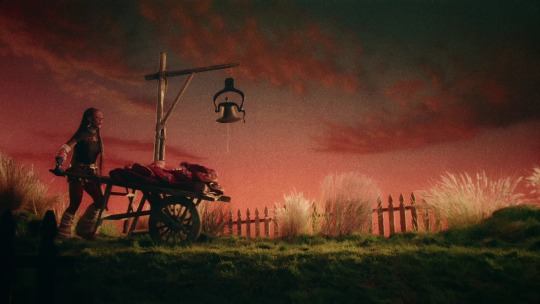

From a philosophical standpoint, it is indeed accurate that “Paint the Town Red” appears as a dynamic, vibrant piece of art. The video draws audiences into a dreamlike, fantastical universe. The images combine elements of Renaissance art with contemporary installations, showcasing boldness, provocation, and an undeniable presence. In the music video, Doja is depicted in multiple forms: as a devilish being with horns, within a majestic court encircled by unsettling figures, and in blood-red surreal landscapes. This is where we begin to observe intentional references to art history, ranging from surrealist inspiration to the striking lighting found in Baroque artwork. The depiction of the devil notably serves as a strong commentary on how society vilifies women who have the courage to express their opinions. A clear illustration of this is how the media frequently depicts outspoken women as contentious individuals. Still, this text could offer a daring and controversial challenge to social standards.
Modern examples of art often break norms and challenge perceptions, and Doja Cat channels that spirit beautifully in this video. The visuals in “Paint the Town Red” are more than just eye candy; they’re layered with meaning. In definition, semiotics is the study of signs and symbols—and this video is brimming with them. The hyper-saturated colors, exaggerated proportions, and surreal settings create a dreamlike atmosphere that feels deeply symbolic.
It is best summarized by the concept of the author Ayn Rand, in which art is described as the "selective re-creation of reality according to an artist's metaphysical value judgments." Doja redefines modern art by merging it with music into one full sensory experience. Each scene feels like a painting come to life.
------------------------------------------------------------------------------
Merging Visual Arts and Music for an Immersive Narrative

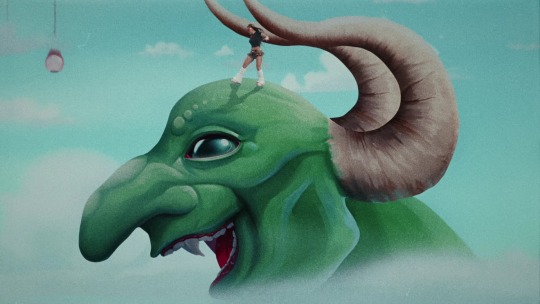
My claim is best demonstrated by the concept proposed by transmedia storytelling, where interconnected layers of meaning emerge across different platforms. In this video, Doja is not just performing; she's embodying the themes of the song-empowerment, defiance, and individuality. It is no secret that the use of symbolism in this video bridges the gap between high art and pop culture. Numerous viewers, have shown a renewed admiration for contemporary and surrealist art due to Doja’s visuals. Therefore, it is reasonable to assert that this capacity to motivate and inform via art renders “Paint the Town Red” far beyond just a music video; it is a cultural landmark.
Having examined the subject thoroughly, I believe this was not only a brilliant concept for representing contemporary art, but it also showcases Doja’s talent for creating narratives that profoundly connect with audiences. We also discovered in the seminars that the combination of media types—such as music and visual arts—produces deeper, more engaging experiences. Although certain individuals may contend that her themes divide opinions, this very fact demonstrates the importance of her work. Primarily, art is intended to stir emotions, which it accomplishes effectively. It’s striking, it’s gorgeous, and it’s certainly a reflection of her creative perspective.
Sources:
Rolling Stone, 2023. Doja Cat Talks About Her Artistic Vision and Challenges in ‘Paint the Town Red’. [online] Available at: https://americansongwriter.com/the-meaning-behind-doja-cats-surging-hit-paint-the-town-red/ [Accessed 2 Jan. 2025].
YouTube, 2023. Doja Cat – Paint the Town Red (Official Video). [online] Available at: https://youtu.be/fjixfrP2VU8?si=P4MVUYL5ebQECWqH [Accessed 2 Jan. 2025].
The List, 2023. Real Meaning Behind Doja Cat’s “Paint the Town Red”. [online] Available at: https://www.thelist.com/1407812/real-meaning-doja-cat-paint-the-town-red/ [Accessed 2 Jan. 2025].
Intersect Magazine, 2023. Doja Cat: Paint the Town Red Review. [online] Available at: https://www.intersectmagazine.com/post/doja-cat-paint-the-town-red-review [Accessed 2 Jan. 2025].
In the Loop 929, 2023. Review: Paint the Town Red by Doja Cat. [online] Available at: https://intheloop929.wordpress.com/2023/10/21/review-paint-the-town-red-by-doja-cat/ [Accessed 2 Jan. 2025].
#doja cat#surreal#paint the town red#visual storytelling#immersive experience#art style#modern art#music#contemporary art#Youtube
1 note
·
View note
Text
Blog #09- Medium Specificity in Horror
With this blog post, I aim to examine how manga as a medium specifically can stir up psychological anxiety. As a game designer, I find it quite fascinating how certain types of media can arouse feelings, particularly terror. While horror in film and literature is well-known, manga offers a unique style of delivering horror stories that blends both visuals and narrative. In order to carry out a thorough analysis, I'll examine two pieces for this: Hitoshi Iwaaki's 'Parasyte' and Junji Ito's 'Uzumaki' to demonstrate how medium-specific approaches may produce a lasting impression.
While their storytelling styles differ, they share a similarity in using the manga as a medium to create immersive horror experiences. Together, these two works show that manga can incorporate visual artistry, complex storylines, and thematic weight in a manner that elicits intellectual and visceral responses.
-------------------------------------------------------------- Parasyte
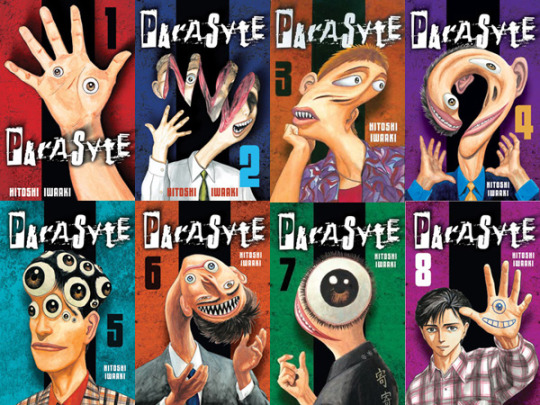
Hitoshi Iwaaki is among Japan’s most renowned manga artists, recognized for his skill in blending gripping narratives with intellectual depth. Much of his works incorporate elements of Japanese folklore, modernized for contemporary audiences. His most renowned work, 'Parasyte', exemplifies this talent perfectly. The manga,published between 1989 and 1995, has led to various adaptations throughout the years, such as the anime 'Parasyte -the maxim', live-action films, and the South Korean series 'Parasyte: The Grey'. Despite these adaptations, the original manga still stands as the definitive version, highlighting Iwaaki’s skill in storytelling. Let me begin by setting some context onto 'Parasyte'. Fundamentally speaking, Parasyte follows the tale of Shinichi Izumi, a young man who is partially infected by an alien parasite that seizes control of his right hand. The story follows the coexistence of these two and their battle against the grotesque parasites that feed on humans and threaten humanity.
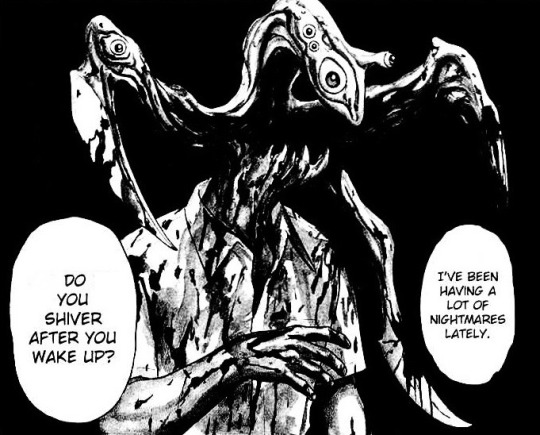
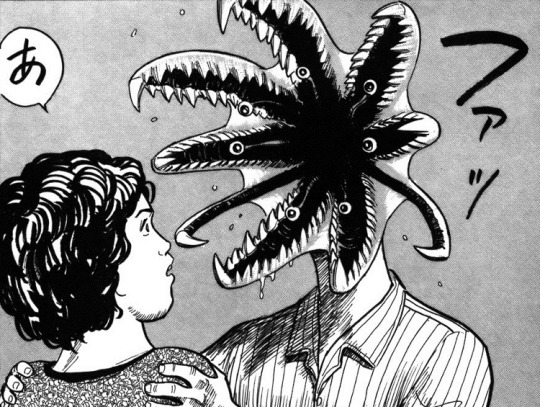
In definition, semiotics is the study of signs and symbols, and Parasyte excels in using visual semiotics to heighten horror. For instance, the parasites’ grotesque transformations—a head bursting open to expose sharp teeth—are unforgettable. To illustrate, when it is first discovered, the parasite’s ability to twist its host’s body into monstrous forms leaves the reader both horrified and fascinated. The rhythm is an additional strength. Iwaaki’s use of sequential art ensures that each panel builds suspense, whether through rapid action or lingering on chilling details. From a philosophical perspective, it is in fact the combination of art, narrative, and existential themes that creates what some call a “total work of art”. The story delves into deep questions about identity, humanity, and survival. The parasites themselves act as metaphors for humanity’s destructive tendencies, making readers question what it truly means to be human. In this manner, Iwaaki modernizes elements of Japanese folklore while drawing from Lovecraftian cosmic horror, where incomprehensible forces challenge human understanding.
------------------------------------------------------------------------------
Uzumaki

Junji Ito has an iconic name in horror manga, renowned for his ability to turn the ordinary into the terrifying. His creations are deeply influenced by Lovecraftian cosmic horror and Japanese folklore, creating unsettling narratives that linger in the reader’s mind. Uzumaki, published in 1998, is perhaps his most iconic work, narrating the tale of a little town haunted by spirals. Speaking of Uzumaki, The manga tells the story of a small town cursed by spirals. At first, the spiral motif seems harmless—a snail shell or swirling water—but it quickly transforms into a representation of insanity and despair, engulfing the thoughts and bodies of the town’s residents.


What really sets Ito's work apart, is the detailed and grotesque art style. His line work makes the spirals feel alive and menacing. Perhaps most chilling is the Jack-in-the-Box chapter, where a young boy's obsessive crush leads to his terrifying demise, and he later reappears as a grotesque, spring-activated cadaver. Another memorable scene features villagers turning into enormous snails, a slow and bizarre transformation that reflects the widespread impact of the spirals. These instances highlight Ito's talent for transforming surreal situations into profoundly disturbing encounters. The spirals serve as symbols for fixation and disorder, illustrating humanity’s propensity for self-destruction. Ito combines these visual elements with elements of psychological and cosmic horror. Similar to Lovecraftian stories, the beginnings of the spirals are unclear, rendering the unknown a source of dread. Every chapter expands on the previous one, forming a spiraling decline into turmoil that pulls readers further into the curse. Uzumaki has significantly impacted horror media, encouraging manga creators, filmmakers, and game designers to explore deep unease and complex imagery. The best way I can describe its impact is that it uses every strength of the manga medium to create a suffocating and unforgettable experience. Modern examples of their influence include adaptations, though these often fail to capture the depth and nuance of the original works.
Both creators incorporated elements from Japanese folklore and Lovecraftian horror, modernizing these influences to resonate with contemporary global audiences. Parasyte uses grotesque transformations and existential questions to examine the vulnerability of human identity, whereas Uzumaki utilizes captivating visual elements and psychological fear to immerse readers in a world spiraling toward chaos.
Their unique approaches demonstrate how the manga format, with its sequential art and controlled pacing, excels at crafting atmospheric and thought-provoking horror. These works remind us that horror is not just about shock and gore but about exploring the unknown, the uncanny, and the depths of the human psyche. For me as a game designer, Parasyte and Uzumaki are not just exceptional horror stories; they are lessons in how to use a medium’s strengths to create unforgettable emotional experiences.
Sources:
Graphic Library, 2024. Parasyte: Vol. 1 by Hitoshi Iwaaki. [e-journal] Available at: https://www.graphiclibrary.org/reviews/parasyte-vol-1-by-hitoshi-iwaaki. [Accessed 27 Dec 2024].
Blogcritics, 2024. Manga Review: Parasyte by Hitoshi Iwaaki. [online] Available at: https://blogcritics.org/manga-review-parasyte-by-hitoshi-iwaaki/. [Accessed 27 Dec 2024].
Torn Nightfire, 2024. Humanity, Desire, and Unease in the Work of Junji Ito. [online] Available at: https://tornightfire.com/humanity-desire-and-unease-in-the-work-of-junji-ito/. [Accessed 27 Dec 2024].
Rehnwriter, 2024. Junji Ito: How He Scares Us. [online] Available at: https://rehnwriter.com/book-recommendations/junji-ito-how-he-scares-us/. [Accessed 27 Dec 2024].
YouTube, 2024. Uzumaki: Full Series Review. [online] Available at: https://youtu.be/5PMuJwYLL14. [Accessed 27 Dec 2024].
The Artifice, 2024. Parasyte Analysis. [online] Available at: https://the-artifice.com/parasyte-analysis/. [Accessed 27 Dec 2024].
The Artifice, 2024. Junji Ito. [online] Available at: https://the-artifice.com/junji-ito/. [Accessed 27 Dec 2024].
#manga panel#manga#junji ito#hitoshi iwaaki#parasyte#uzumaki junji ito#semiotics#japanese#japanese folklore#horror#gore#artwork#medium specificity#grotesquerie#gesamtkunstwerk
0 notes
Text
Blog #08- Colour as Narrative
When I decided to explore 'Everything Everywhere All At Once' for this blog, it wasn’t just about celebrating a brilliant film. It was about delving into how visual language, particularly colour, can act as a powerful narrative tool. This film felt like a masterclass in using colour and cinematography to guide audiences emotionally and philosophically. It’s a benchmark not just for cinema but for creative media as a whole.
youtube
Watching 'Everything Everywhere All At Once' felt like encountering a visual language so fluent that it could express the chaos and meaning of existence itself. The film’s audacious use of colour made me reflect on how I could push the boundaries of visual storytelling in my own work.
Released in March 2022, Everything Everywhere All At Once is a sci-fi-comedy-drama that defies categorization. It follows Evelyn Wang, a middle-aged Chinese immigrant and a laundromat owner struggling with tax issues, family conflict, and existential despair—until she’s thrust into the multiverse. Evelyn discovers she must connect with parallel versions with of herself to save all of existence from collapsing into the void of meaninglessness, embodied by the "everything bagel". Ultimately, this film is about finding your way through the absurdity of life while hanging onto the relationships and personal growth. It’s a deeply impactful human story wrapped in the dazzling shell of chaos of multiversal action and absurdist humour. Its genre-bending nature mirrors the fragmented reality it portrays, making it a rich text for analysis.
The Role of Colour in Storytelling
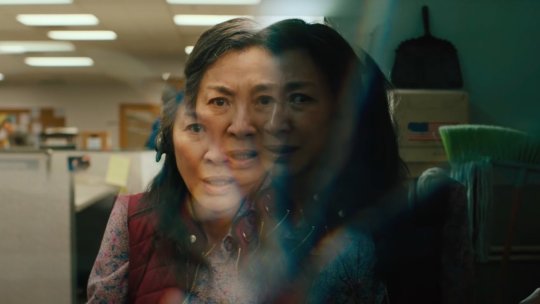


One of the film’s standout features is its exceptional use of colour to define emotional states and universes. Larkin Seiple’s cinematography turns each multiverse into its own distinct visual realm:
The IRS Universe- Dominated by muted grays and beiges, this universe reflects Evelyn’s mundane and oppressive reality. The lifeless palette reflects her sense of imprisonment and immobility.
Hot Dog Fingers Universe- This absurd and comedic reality explodes with vibrant, almost cartoonish colours, enhancing its surreal and grotesque humour. The garish hues make the ridiculousness of this universe unforgettable.
Rock Universe- The absence of colour and sound creates a stark, minimalist world. It’s a place of retreat and reflection, a visual pause from the film’s chaotic energy. The black-and-white imagery underscores the serenity of simply existing.
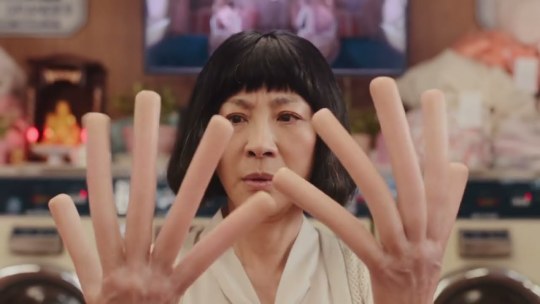
Throughout the film, colour shifts dynamically to reflect Evelyn’s emotional journey. Saturated tones heighten the intensity of fight scenes, while soft pastels bring warmth to moments of connection. This deliberate use of colour not only distinguishes each universe but also immerses the viewer in Evelyn’s tumultuous inner world.
------------------------------------------------------------------------------
Philosophical Depth and Emotional Symbolism
The power of this movie is in its ability to communicate philosophical ideas on a visual level. One of the most poignant moments is the "rock scene," wherein Evelyn and her daughter Joy exist as lifeless rocks in a barren landscape. Many interpret this as Evelyn hitting "rock bottom," but it goes much deeper. The scene symbolizes her active decision to run away from the overwhelming burden of her interwoven lives. In a universe that has no emotions, responsibilities, and chaos-where being a rock was enough-she finds peace. It's not exactly "rock bottom"; it's an escape from the overwhelming burden of existence, a retreat back to a universe where nothing will be required of them, and that simplicity can be profoundly comforting.
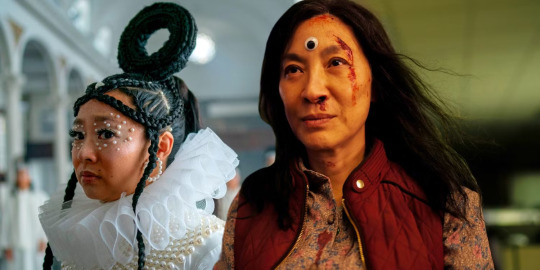
And then, of course, there is nihilism: the thematic element of the "everything bagel," denoting that nothing matters. The everything bagel is the almost comic imagery of the futility and randomness in life. Although the film captures the horrible terror of the world where anything is possible and nothing is fixed, it also offers in return the possibility to choose in a freedom-meaning and connection. This dichotomy-chairs and hope-really resonated with me. But instead of succumbing to despair, the film counters this with a message of hope: If nothing matters, then we are free to choose what matters to us. This balance between chaos and meaning resonated deeply with me, whose life is often overcome by the demands of creative work.
------------------------------------------------------------------------------
Why This Film Resonates with Me
youtube
The part that inspired me the most about this film is that its truly remarkable visual effects were accomplished by a mere team of five individuals. Numerous viewers and critics on YouTube and Reddit mentioned that this small team succeeded in surpassing industry giants such as Disney, Warner Bros, Universal, and Sony. This clearly demonstrates that enthusiasm and innovation can outpace large budgets and resources.


Aside from its technical excellence, the film’s story and imagery resonate profoundly with modern cultural discussions. It redefines conventional storytelling by placing a middle-aged immigrant woman at the forefront as its hero, breaking stereotypes regarding who can be the main character in a sci-fi epic. Evelyn’s challenge to harmonize her cultural and generational identity with her own ambitions mirrors a common human experience. Thus, this investigation of identity seemed especially significant as I traverse my own artistic path in a world that is becoming ever more intricate. The film is absurd, random, and just like life, very unpredictable; it is within this chaos that beauty and meaning can be found. Overall, as mentioned previously in the blog, the role of colour, cinematography, and narrative complexity as instruments that expand the limits of what cinema can accomplish.
Sources:
Screenrant. (2022). Everything Everywhere All At Once: The Real Meaning Explained. Available at: https://screenrant.com/everything-everywhere-all-at-once-real-meaning-explained/ (Accessed: 26 December 2024)
The New York Times. (2022). Review: Everything Everywhere All At Once. Available at: https://www.nytimes.com/2022/03/24/movies/everything-everywhere-all-at-once-review.html (Accessed: 26 December 2024)
Kuegler, T. (2022). Why Everything Everywhere All At Once Is Addicted To Color And What It Means. Medium. Available at: https://tomkuegler.medium.com/why-everything-everywhere-all-at-once-is-addicted-to-color-and-what-it-means-cdb07dd475c0 (Accessed: 26 December 2024)
Backstage. (2022). Interview with the Cinematographer of Everything Everywhere All At Once. Available at: https://www.backstage.com/magazine/article/everything-everywhere-all-at-once-cinematographer-interview-75933/ (Accessed: 26 December 2024)
WIRED. (2022). The Making of Everything Everywhere All At Once. Available at: https://www.youtube.com/watch?v=hFFopPPrGiE&ab_channel=WIRED (Accessed: 26 December 2024)
ThomasFlight. (2022). Cinematography Breakdown of Everything Everywhere All At Once. Available at: https://www.youtube.com/watch?v=VvclV0_o0JE&ab_channel=ThomasFlight (Accessed: 26 December 2024)
#everything everywhere all at once#colour grading#cinematography#movie breakdown#storytelling#visual storytelling#multiverse#universe#film analysis#film making#scifi#Youtube
1 note
·
View note
Text
Blog #07- Dystopian Semiotics in Black Mirror

When I first started thinking about how narratives build their worlds, I couldn’t help but be drawn to Black Mirror. As a game designer, I constantly strive to create immersive experiences where players not only interact with the story but also feel deeply connected to the world. Black Mirror is a fantastic case study because it masterfully uses visual and narrative elements to construct dystopian realities that resonate with audiences. This blog is my attempt to analyze how these techniques in Black Mirror inspire my own creative processes.
Black Mirror is an anthology series created by Charlie Brooker which was first aired in 2011. Every episode is standalone and peers into the dark side of technology - the things it would bring upon us, or is bringing upon us, humankind. Situated in speculative futures, the series delves into topics such as surveillance, AI, social media, and virtual realities, often exposing frailties of human nature when mixed with technological extremes. Through its sharp storytelling and critical tone, Black Mirror invites viewers to confront the anxieties of modern life. The show’s genre combines elements of dystopia, science fiction, and psychological drama, making it an ideal subject for analyzing the semiotics of dystopian storytelling.
The study of signs and symbols, or semiotics, is central to Black Mirror's world-building. When paired with narrative patterns, visual signals like colour schemes and production design produces a multi-layered meanings that mirror the show's broader social and technological criticisms.
Visual and Narrative Analysis
1. San Junipero: A World of Escapism San Junipero immediately caught my attention with the bright colors and setting of the 1980s. From the very first moments, it is much lighter compared to other series, but only until the main idea of mortality versus virtual reality can be revealed. This is where, in this episode, Yorkie and Kelly find each other in the virtual town of San Junipero-where anyone can visit and relive their youth. As it wears on, it becomes clear that San Junipero is a form of virtual afterlife, where people can choose to spend eternity when their physical bodies die. It raises serious and deep ethical and emotional questions about the nature of life and death.
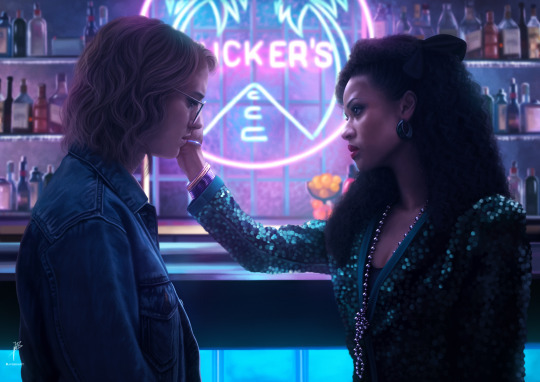

Visual Semiotics: The viewer is immediately presented with comforting and familiar elements such as a neon-lit beachfront, retro arcade games, and very nostalgic fashion. These symbols mean to me a very clear sense of escape into a world both idyllic and artificial. This is contrasted with a colorful simulated world versus a grayish-colored real world-a point that really drives home the idea of escaping reality. Narrative Semiotics: The revelation that San Junipero is a virtual afterlife raised questions about authenticity and human connection. I was struck by the idea of choosing the eternal digital life over the natural cycle of life and death. It made me wonder about how could I possibly incorporate such similar moral choices in interactive narratives to engage players on an emotional level.
2. Nosedive: The Fragility of Social Validation Nosedive hit close to home because of how accurately it critiques social media culture. In this episode, society is governed by a social rating system where every interaction contributes to an individual’s public score. Lacie, the protagonist, becomes obsessed with improving her score to gain social standing and achieve her dream of moving into an exclusive housing development. Her journey spirals out of control, resulting in a catastrophic breakdown that leaves her isolated and free from the system’s suffocating expectations.


Visual Semiotics: The pastel colour choice of the environments and overly curated spaces perfectly symbolizes the superficial perfection this society demands. The omnipresent use of smartphones and augmented reality reminded me of how technology has become an extension of ourselves. For my work, this episode reinforces the importance of using visual design to reflect the themes of a story. Narrative Semiotics: Lacie’s downfall is a powerful reminder of the dangers of basing self-worth on external validation. The episode made me reflect on how I can incorporate similar cautionary tales in my games, perhaps by creating systems that challenge players to evaluate their decisions and values.
Besides these two episodes, Black Mirror is a treasure trove of ideas. For instance, The Entire History of You deals with the concepts of surveillance and memory, while White Christmas looks at artificial intelligence from an ethical viewpoint. These episodes provoke me into thinking about how technology shapes not just the world but also personal identity and relationships. I often think about how the semiotics of dystopia in Black Mirror can translate to game design. Games, like films, rely on a combination of visual and narrative elements to create immersive experiences. Watching Black Mirror has taught me how to use symbolism and contrast to elevate storytelling.
Black Mirror has grown beyond a series for me; it's a source of inspiration. The ability to merge speculative fiction with everyday problems has really made me appreciate the power of storytelling anew. Being able to analyze episodes like San Junipero and Nosedive allowed me to gain an even greater understanding of how all these visual and narrative elements are put together in constructing a persuasive dystopian world. Further into my career in game design, I hope to be able to infuse these insights into my work, creating experiences that will challenge players and force them to reflect on their own realities.
Sources:
Brooker, C., 2011. Black Mirror. [TV Series]. Netflix. [Accessed 15 Dec. 2024].
Johnson, S., 2017. ‘The Semiotics of Technology in Black Mirror’. Journal of Media Critique, 3(2), pp. 45-56. Available at: https://www.journalofmediacritique.com. [Accessed 15 Dec. 2024].
Williams, R., 2016. ‘Black Mirror: The Intersection of Tech and Morality’. The Guardian. Available at: https://www.theguardian.com. [Accessed 15 Dec. 2024].
YouTube, 2018. ‘Exploring Black Mirror: San Junipero’. Available at: https://www.youtube.com. [Accessed 15 Dec. 2024].
Ellis, G., 2019. ‘Dystopia and Design: Lessons from Black Mirror’. Game Studies Weekly. Available at: https://www.gamestudiesweekly.com. [Accessed 15 Dec. 2024].
Reddit, 2024. Various discussions on Black Mirror analysis. Available at: https://www.reddit.com. [Accessed 15 Dec. 2024].
#black mirror#netflix#storytelling#dystopia#virtual reality#technology#narrative#speculative fiction
1 note
·
View note
Text
Blog Post #06- Sound Design in Dead Space

In this particular blog post I will breakdown the notion of sound design as it contributes to the heightening of tension and horror in Survival Horror games using Dead Space (2008) as the main example. Because as a game designer, it's important to learn about the effects of audio elements in creating immersive experiences that players will remember. Let me introduce the framework of the game first of all. Dead Space, developed by EA Redwood Shores and released in 2008, is set in a dystopian future where engineer Isaac Clarke must find his way through the abandoned spaceship USG Ishimura. The storyline is basically interwoven with survival, horror, and mystery as Isaac tries to unravel the truth behind the Necromorph outbreak. But, as I said earlier, this would not have such an impact on the narrative without the masterful integration of its sound design. For example, the immediate eerie silence versus the jolting mechanical creaks of the USG Ishimura when first discovered set an haunting tone right away. This is best articulated by the composer, Jason Graves, who described how the approach was more about creating "textures and mood" rather than melody. Theoretically speaking, it is, in fact, a non-traditional approach that launches the audio into the status of narrative device.
Innovative Techniques in Audio Design:
Using the original audio recordings already represents a sure sign of how dedicated the team had been in bringing forth unique sounds. First, an audio team recorded raw sourced material on rare locations and applied boutique processing plugins, analogue synthesizers, and experimental techniques in creating futuristic sound. This really enhances the audio palette's feeling of realistic immersion within this game.
youtube
Moreover, dynamic music fits smoothly in-game. Graves employed features such as dissonant strings, crazy patterns, and new ways of playing instruments, like bowing cymbals, to create feelings of unease. My argument can be best explained when, from an almost subtle ambient tension, the music shifts into loud cacophony during action moments; in this case, the player's are always engaged emotionally and psychologically.
The use of Ambient Sounds :
Another way which the game shows off its audio design is through the use of background noises. For example, old structures of the Ishimura, the distant sound of machinery, and low voices instill fear in the movie. In definition, this use of sound engulfs the player as well as makes them feel exposed in one way or the other. The only way I can relate this portrayal of reality is by speaking about Isaac’s breathing and heartbeat which ever change with his or her health and stress levels at a given time. Such physiological feedback makes it quite easy for players to – at least – feel that they are experiencing Isaac in their own skin.
Despite the audiences knowing there is an ‘evil’ waiting for them at every turn, it is the lack of music that most scares. Modern examples of this technique include games like Alien: These are isolation that employs the use of silence to amplify the noise that ensues. Dead Space, however, goes a tad further by allowing environment sounds to come with a form of life of its own, leaving the players constantly feeling groping.
The Power of Silence:
After having explored the topic at hand, it is fair to say that the sound design in Dead Space is a masterclass in audio innovation. The contrary was proven when games with generic audio libraries failed to deliver the same level of immersion. In conclusion, all the aspects discussed in this blog have shown just how important sound design as a narrative tool in gaming is.
With the addition of dynamic audio, ambient sounds, and physiological feedback, Dead Space is so much more than its visuals and narrative. As I said earlier in this post, sound design is not merely a background feature—it is an essential driver of emotion, tension, and player engagement. For game designers, the lessons from Dead Space’s audio approach provide invaluable insights into crafting immersive gaming experiences.
Sources:
Jason Graves, & Rod Abernethy, 2008. The Music of Dead Space: Artistic Design and Technical Implementation. Music 4 Games. Available at: https://www.music4games.net/ [Accessed 28 Dec. 2024].
Jason Graves, 2008. The Soundtrack of Dead Space. Music 4 Games. Available at: https://www.music4games.net/ [Accessed 28 Dec. 2024].
Graves, J., 2008. 'Dead Space Sound Design in Space: No One Can Hear Interns Scream – They Are Dead.' Original Sound Version. Available at: http://www.originalsoundversion.com/dead-space-sound-design-in-space-no-one-can-hear-interns-scream-they-are-dead-interview/ [Accessed 28 Dec. 2024].
Source details from Reddit about Dead Space Sound Design, 2024. Available at: https://www.reddit.com/r/DeadSpace/comments/mi9817/sound_design/ [Accessed 28 Dec. 2024].
Source details from Reddit about Dead Space Sound Design, 2024. Available at: https://www.reddit.com/r/DeadSpace/comments/1eu4v7x/the_sound_design_in_the_remake_is_phenomenal/ [Accessed 28 Dec. 2024].
1 note
·
View note
Text
Blog Post #05- Ellie’s Emotional Arc
In this post, I will analyze the game The Last of Us Part II and how its emotionally charged narrative takes a toll on the players on a psychological level. The way this game explores grief, vengeance, trauma, and healing is not a backdrop for the story, but rather the core of its emotional resonance. I chose this because of how this game deeply influenced me and others into reflecting on such sensitive matters: the cycle of violence and the human capability for healing.

The Last of Us Part II is an action-adventure game developed by Naughty Dog and published by Sony Interactive Entertainment in 2020. It is a direct continuation of The Last of Us (2013), wherein a post-apocalyptic world finds its population obliterated by a fungal infection that eventually mutates into grotesque monstrous creatures.
Before diving into the details, it's important to first understand the storyline of the game. The game features Ellie as she sets out to take revenge on Abby, a Washington Liberation Front (WLF) member, for the vicious murder of her father figure, Joel. Joel's actions in the first game, where he killed Abby's father, a significant player in the Firefly organisation, to prevent Ellie from being used in an experimental cure, are linked to Abby's grudge.
Though their inner conflicts provide a deeper understanding of justice, anguish, and retribution, Ellie and Abby are also motivated by sadness and a desire for vengeance. The themes of loss, retribution, the repercussions, and what may be worth fighting for are all extensively explored in the story. It merges an interactive game with poignant narrative beats. By the time pivotal moments unfold, such as Joel's death, Ellie's revenge mission, the final confrontation, and Ellie's ultimate choice, the game shows how trauma and vengeance interlink, ultimately how they can be conquered.
1. The Death of Joel
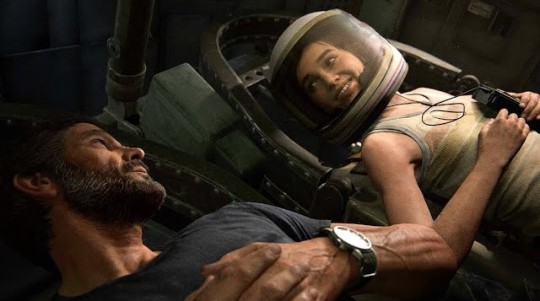
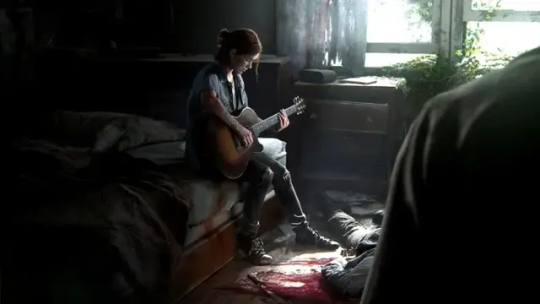
First and foremost, Joel’s death is a defining moment in The Last of Us Part II, setting the emotional tone for the entire game. For Ellie, Joel was not just a protector but the closest thing she had to family after the traumatic losses she endured. His vicious death at Abby's hands sends Ellie down a path of sorrow and anger, driving her to pursue her one and only objective: revenge. Because Ellie is motivated by this personal grudge, the player sees the world through her angry and justifiably demanding eyes. But as Ellie takes life after life in her unrelenting quest, what starts off as a moral quest for vengeance soon begins to feel hollow.
2. Ellie’s Mission of Revenge
As Ellie embarks on her mission to track down Abby, the consequences of revenge begin to unfold. In each encounter, Ellie kills without hesitation, and while these moments may seem cathartic at first, they gradually feel hollow. Every time she kills someone, Ellie becomes further away from who she was, as that hollowness can be expressed in the emotional toll it takes on her. The more she walks into the journey of vengeance, the clearer it is-with each kill, her pain and emptiness are becoming deeper. Ellie's anger does not stay anywhere, yet the revenge appears as an endless cycle-a cycle which is difficult for her to get out of.
3. The Final Confrontation: Ellie and Abby
The final confrontation between Ellie and Abby is emotional. Both characters are driven by their grief-one having lost her loved ones to the brutal way of the world-and now they must face the consequences of their actions. Here we can clearly see that the fight is brutal, but it's more than just physical-it's a moment of reckoning. Only by the final acts does Ellie or Abby realize violence won't yield either of their desperately wanted peace. That is a painful, sad truth forced on all gamers: the only true revenge might just create a vicious circle of violence and suffering.
youtube
4. Ellie’s Final Choice: Letting Go of Vengeance
Ellie now has to make a decision after everything she has endured, including Joel's passing, the lives she has taken, and Abby's unrelenting pursuit. The most moving scene in the game occurs when Ellie lets go of Abby. This decision marks a significant shift in Ellie’s character. She chooses to stop the cycle of vengeance. Letting go of revenge is not just an emotional release for Ellie; it’s a moment of self-realization. She understands that holding onto this pain has consumed her, and only by letting it go can she begin to heal. The emotional toll of her choices comes full circle here, and the player is left with a sense of quiet sorrow and tentative hope. Ellie’s final choice, her willingness to relinquish vengeance, signifies her growth—not just as a character but as a person. This act of Ellie letting go of Abby draws a line on one long cycle of hurt and loss while opening the gates for recovery and healing. Beautiful, though wrenching, way to culminate the journey marred by agony, suffering, and personal growth.
Thus, it is fair to say that Ellie’s transformation is not just physical but emotional. Letting go of revenge is a crucial step in her healing process, a realization that revenge does not lead to peace. The audience's criticism and disconnection highlight the moral dilemma at the heart of the game—whether vengeance truly brings justice or merely perpetuates suffering.
All in all, the aspects discussed in this blog highlight the complexity of human emotion and the impact of trauma. Through Ellie’s journey, The Last of Us Part II explores how grief, vengeance, and healing shape our decisions and relationships. The game doesn’t just ask players to sympathize with its characters but challenges them to reflect on their own beliefs about justice and forgiveness.
Sources:
Fawzi, A., 2020. Vengeance, Trauma, and Healing: The Narrative of The Last of Us Part II. Narrative Psychology in Gaming. Available at: https://www.narrativepsychologygaming.com [Accessed 25 Dec. 2024].
Mediatonic, 2020. The Last of Us Part II: Analyzing the Impact of Trauma and Grief in the Game. Gaming Psychology Journal. Available at: https://www.gamingpsychologyjournal.com [Accessed 25 Dec. 2024].
Naughty Dog, 2020. The Last of Us Part II. Sony Interactive Entertainment.
Sony Interactive Entertainment, 2020. The Last of Us Part II - Official Game Guide. Available at: https://www.playstation.com [Accessed 25 Dec. 2024].
0 notes
Text
Blog Post #04- Storytelling Through Stray
In this blog post, I will explore how Stray, a third-person cat adventure game evokes deep emotions within players through its unique storytelling, innovative design, and non-human protagonist. Stray demonstrates just how deeply immersive video game narratives can be. Further I will examine the visual style of the game, its apocalyptic setting, and minimalist storytelling techniques.

Developed by BlueTwelve Studio, Stray is a 2022 video game where a stray cat explores a post-apocalyptic cyberpunk city. Drawing inspiration from the stray cats of Montpellier, France, the developers tried to capture the feline experience authentically.
The game’s standout feature is its realistic portrayal of cat behaviour. Rather than using motion capture, the team relied entirely on traditional keyframe animation techniques. Animator Miko observed real cats, studying their movements to replicate them in the game. This method gave the team the freedom to imagine how a cat might behave in specific scenarios, even extrapolating from real-world knowledge when faced with situations no cat would naturally encounter. Thus, it resulted in a deeply immersive experience making it feel lifelike and believable, and more emotionally connected to the players.
I find it fascinating as an environment artist how visual storytelling can portray complex emotions. Stray caught my attention because it tells a relatable story with a non-human protagonist. Through this game, I was able to look into how immersive worlds can be created in which the environment and visuals say much more than words. Stray pushes me to go out of the box in my projects and explore unconventional ways to connect with players
------------------------------------------------------------------------------
The Look, Feel, and Style of the Game


Stray is visually stunning, with its cyberpunk city blending vibrant neon lights and decaying architecture. The atmosphere evokes a sense of nostalgia and loss, as remnants of human life—graffiti, posters, and abandoned technology—tell silent stories of a vanished civilization. The vertical design of the city reflects societal hierarchies, with affluent areas closer to the sky and impoverished robots living below. The game’s art style balances realism and stylization. The cat’s animations are lifelike, while the robot characters have a charming, human-like quality. Lighting plays a crucial role, with warm, flickering hues contrasting against cold blues to create a hauntingly beautiful world. This combination of design elements draws players into the narrative, making the world feel alive despite its desolation.
------------------------------------------------------------------------------
Environmental Storytelling in a Cyberpunk Dystopia
The environment in Stray is more than just a backdrop; it's an active storyteller. The game takes place in a post-apocalyptic world where humans have vanished, and left behind is a society of robots. Every little detail, from books lying abandoned to graffiti made by robots, adds layer upon layer to the narrative. The city's design encourages exploration, with every corner offering clues about the world's history. The companion robot, B-12, acts as a guide and translator, giving just enough exposition to keep the story coherent without spelling out much for the player. The minimalist approach of the game, allow players to piece together the story through observation, and making it feel deeply personal.


At its core, Stray is a tale of survival, affection, and hope. Playing as a stray cat creates a feeling of vulnerability and resilience. Companionship seems to play a role in a world full of loneliness between the protagonist and B-12, adding to that depth. The lack of traditional dialogue places greater emphasis on the visual and audio storytelling. Subtle animations, detailed environments, and a haunting score combine to evoke powerful emotions. This game is one example of how to tell a powerful story without words, making Stray a leader in narrative design.
------------------------------------------------------------------------------
Stray is widely praised for its emotional depth and its ability to whisk gamers away into its world. For many players, the game really had something new to say about storytelling, mainly using a cat as the protagonist. The thinking here is that such a non-human perspective creates a very fresh, vulnerable way for the player to go through a narrative and makes emotional connections with the character and its world even more resonant. Critics, in their reviews have highlighted the game’s seamless blend of gameplay and narrative.
It is a brilliant example of how far video games can push the limits of narrative. It delivers a unique experience through its realistic animations, rich environments, and emotional depth, leaving a lasting impact that will linger long after the game is over. To game artists and designers, Stray stands as a testament to visual storytelling and an inspiration toward the discovery of new ways to engage players.
Sources:
The Verbal Thing, 2022. Stray Game Thoughts. Available at: https://theverbalthing.com/news/stray-game-thoughts [Accessed 15 Dec. 2024].
Blogging with Dragons, 2022. You Need to Play Stray. Available at: https://bloggingwithdragons.com/you-need-to-play-stray/ [Accessed 15 Dec. 2024].
Abby’s Blog, 2022. Stray. Available at: https://abbysblog.net/blog/stray [Accessed 15 Dec. 2024].
Yellow Brick Road, 2022. How Stray Became a Masterpiece in Storytelling. YouTube. Available at: https://youtu.be/YnjZy4l4xR4?si=i96BzrLu8nMJ2Kov [Accessed 15 Dec. 2024].
Game Makers’ Insights, 2022. Creating the World of Stray. YouTube. Available at: https://youtu.be/nujjCmABO7Y?si=EKVeaLzaqiU9YRaO [Accessed 15 Dec. 2024].
7 notes
·
View notes
Text
Blog Post #03- Visual and Lyrical Intertextuality
In this blog post I will analyze the song 'The Heart Part 5’ from the American artist Kendrick Lamar and how does it creates an emotional engagement and how effective it is. I explore how the song creates emotional resonance, the meaning of its deepfake visuals, and the cultural commentary embedded in its lyrics. Why did I choose this topic? Because Lamar's work is a master class in the merging of artistic forms to great narrative effect, and because this video moves the very elements of what's possible in storytelling within a musical context.
------------------------------------------------------------------------------
How does Kendrick Lamar creates emotional engagement with his song and create affect in the audience?
Let’s start by setting some context on who Kendrick Lamar is. Kendrick is an American rapper and one of the trailblazers in the field of music. He’s also very well known because of his technical artistry, complex songwriting, along with critical and commercial success. The Heart Part 5 from 2022 carries its own blend of music and technology.
youtube

The video opens with the most minimalist yet striking scene possible: Lamar stands in front of a red background and performs his verses with pure intensity. Notably, deepfakes of cultural icons such as O.J. Simpson, Kanye West, Will Smith, Kobe Bryant, and Nipsey Hussle morph onto his face. It's not only an optical effect but also the most striking and symbolic means through which he explores themes regarding celebrity, morality, and legacy among Black people. With faces and voices so alike, Lamar connects his identity with theirs by stating that, popular or contentious, successful or activist, they are all embodiments of the Black experience. Every single transformation is an invitation to reflect on the lives they lived, what they represented, and how they still influence culture. He gives the song layers with these visuals, making the video not only a music video but a strong tribute to those who shaped Black identity and history. The combination of vivid words and visual narrative gives the song its emotional effect. The lyrics, which deal with themes of love, community, and self-awareness, are candid and insightful. Lamar delivers lyrics like these as he considers his experiences and the cyclical cycle of violence in the Black community: "As I get a little older, I realise life is perspective." This self-examination prepares the reader for a story that alternates between individual and group challenges. Lamar connects the past and present by incorporating a sample of Marvin Gaye's 'I Want You' into his song, giving it a sense of continuity. This sample was specifically chosen to evoke nostalgia and place contemporary issues within historical contexts.
------------------------------------------------------------------------------
The Drums and the Message of Black Culture
The drum in most African cultures represents the heartbeat-the rhythm that knits a community together. As Lamar instructs, "Take the drums out" towards the end of the song, he signals a shift; this creates an eerie silence which lends weight to his words. This moment is particularly powerful as Lamar morphs into Kobe and Nipsey, using their “spirits” to speak on life, legacy, and culture.


As one YouTube comment put it, “The drums represent the heartbeat that gives life to any song.” Removing the drums adds gravity, making us focus on the deeper message Lamar is delivering, especially in the final verses when he channels Kobe and Nipsey. It feels like a spiritual connection, making us feel their presence even though they are no longer with us. It's not only the person Lamar's talking about, he is talking with the condition of the Black community in general. He's looking into the contradictions in culture: what it is that makes it strong, what holds it back. Lamar speaks about mental health, greed, unemployment, and how these issues affect the community. The culture can sometimes be both a source of strength and a trap that keeps people disillusioned.

As another YouTube comment captures, Lamar speaks of the culture as “its best friend, lover, and worst enemy.” He points out how greed and misinformation cloud the truth and hinder the progress of the community. He speaks of mental and spiritual illness. How it effects the ‘culture’ and how greed, unemployment, riches, lies, superimposing information and hidden truth is made to keep us disillusioned.
------------------------------------------------------------------------------
Kendrick Lamar’s The Heart Part 5 isn’t just a song or video. It’s a deep dive into Black culture, legacy, and the struggles that shape it. Through deepfakes and powerful lyrics, Lamar invites us to reflect on the past, present, and future of the community. He highlights the importance of healing, understanding our shared history, and confronting the challenges that still affect us today.
He finally reminds us that culture, as much as it might be important, is also our hindrance. His work really encourages us to break ourselves free from these mental and spiritual burdens placed on Black people and to find a path forward with truth and healing.
Sources:
Kendrick Lamar VEVO. (2022). Kendrick Lamar - The Heart Part 5 (Official Video). Available at: https://www.youtube.com/watch?v=uAPUkgeiFVY [Accessed 24 Dec. 2024].
Wisecrack. (2022). Kendrick Lamar's Heart Part 5: Explained. Available at: https://youtu.be/zvRT9MSv4sw [Accessed 24 Dec. 2024].
MeaganTheeDeveloper. (2022). An Analysis of Kendrick Lamar’s The Heart Part 5. Medium. Available at: https://medium.com/@meagantheedeveloper/an-analysis-of-kendrick-lamars-the-heart-part-5-4e146e085dcb [Accessed 24 Dec. 2024].
Neon Music. (2022). Kendrick Lamar’s The Heart Part 5: A Lyrical Deep Dive and Cultural Touchstone. Available at: https://neonmusic.co.uk [Accessed 24 Dec. 2024].
Nylon. (2022). Kendrick Lamar’s The Heart Part 5 Explores Legacy Through Kanye, Kobe, and Nipsey Deepfakes. Available at: https://www.nylon.com [Accessed 24 Dec. 2024].
#kendrick lamar#intertextuality#the heart part 5#visual storytelling#deepfake#black culture#Intertextuality#Youtube
1 note
·
View note
Text
Blog Post #02- Open-World Storytelling in Games
The purpose of this blog is to investigate one interesting approach in environmental storytelling, where open-world games have become a world without depending on dialogue. Works I will be covering are The Legend of Zelda: Breath of the Wild, Red Dead Redemption 2, and Journey, each representing how environmental storytelling increases immersion and emotional attachment to the players. Lastly, I'll explain my point of view about this approach to storytelling in how gaming shifts to be a peculiarly engaging form of storytelling.
------------------------------------------------------------------------------
What is an Environmental Narrative?
First and foremost, environmental storytelling refers to how stories are told through the setting, architecture, and layout of a game. Semiotics, by definition, is the study of signs and symbols and what they mean. Environmental storytelling works in much the same manner, offering "clues" through ruins and artifacts and spaces that players must interpret.
This is perhaps best summed up by writer Henry Jenkins, who claims that "narrative architecture" allows game settings to hold story fragments that players assemble through their exploration. Thus, one can say that environmental storytelling is an aspect of the improvement in the gamer's experience whereby the environment dynamically contributes to the storytelling.
As presented in the Game Maker's Toolkit video, "Environmental Storytelling – How Level Design Can Tell a Story" by Mark Brown, this video goes deep into how games can tell great stories using their environments without having to use spoken or written words. I chose the subject because environmental storytelling is just one of the most interesting areas of game design, at the same time being an important technique in boosting the player's immersion and providing a game world with life. This storytelling technique will let players organically discover a narrative through exploration of the environment rather than having it directly delivered. This, somehow, gives the feeling of immersion since the player seems to uncover, piece together fragments, and interpret for himself or herself.


It talks about how the worlds themselves can be a canvas for telling stories, how the objects in space can reveal history, culture, or even the emotional state of the characters. A worn doll on the floor of an abandoned home, for instance, may reveal a lot about the abrupt departure of its residents. The most potent narrative device in video games like Uncharted 4 and The Last of Us 2 is the environment. Without stating the specifics of what happened, a player may discover handwritten notes, photos, or even bloodstains that help put together a story. These are the kinds of discoveries that are satisfying.
Overall, this video discusses the high potentiality of in-game environmental narrative. It postulates that with everything-from world-building to level design-working together in harmony, the environment could tell stories that are as powerful as any cutscene or lines of dialogue.
------------------------------------------------------------------------------
The Legend of Zelda: Breath of the Wild – A World of Silent Stories
Let me give a little background using The Legend of Zelda: Breath of the Wild. Upon its release, its open-world design was considered revolutionary. By hiding clues in the landscape, it asks the player to piece together the past and understand the ramifications of the world's history; the environment itself is a key part of the storytelling. In this way, environmental storytelling keeps the player active within the unfolding narrative. Story breathes through the landscape in Breath of the Wild - the ruined temples, decayed structures, remnants of a world past prime. Players will put together a greater tale of storytelling sans words as they explore. This is also explained rather nicely in an article on Medium that explains how the world tells the story of the aftermath of Hyrule's fall through the medium of ruins, weathered monuments, and forgotten shrines.


I remember the first time playing it, finding shrines dotted around the overworld and how their design and positioning in abandoned areas really reflected the decline of the kingdom, with shrines being almost like silent reminders of a civilization lost. They made me contemplate the natural forces that molded this region. This type of environmental storytelling invites reflective contemplation. The world is to be explored and interpreted, not merely a place to be traversed. Every decaying building, every shattered statue, every serene woodland all contribute to the story being told. The weather and day-night cycles are examples of natural phenomena that enhance this storytelling technique. This is one of those games wherein everything-from the weather down to the architecture and the landscapes-tells the story of a people now extinct, proving the adage that not all stories are told by words. Sometimes, at times the most poignant of stories are spoken by surroundings.
------------------------------------------------------------------------------
Red Dead Redemption 2 – The End of an Era
Next up is a masterclass of narrative and world-building in equal measure: Rockstar Games' Red Dead Redemption 2, set in the late 19th century. It uses the richly composited and elaborately detailed environment to make a statement for the end of the Wild West, examples including abandoned mining towns and overgrown railways that dot the expanse of the map.


In Red Dead Redemption 2, for instance: Limpany is a town abandoned, burnt to the ground, and it's a tale of corruption and tragedy without one line of dialogue. When first found, players can learn of the town's fate through visual clues-the charred buildings, scattered belongings, and a ledger that would suggest local corruption. These visual elements are all that's needed to communicate the story of loss and ruin. This is best conceptualized by the writer Ayn Rand, who said that it is the environment that one dwells in which shapes character and dictate the course of a character's actions. In this story, the settings are practically active in changing the characters. Arthur Morgan's campsite changes throughout the video game as his inner struggles do, along with the unraveling of the Van der Linde gang. For me, the beauty of Red Dead Redemption 2 is in how meaningful it can make every corner of its world feel. It's a game that begs to be explored, observed, and reflected on, crafting a very personal narrative experience.
------------------------------------------------------------------------------
Journey – A Silent Pilgrimage
Finally, Journey by thatgamecompany pushes environmental storytelling to its limits by removing dialogue altogether, providing a unique example of how a game can convey deep themes and emotion without using a single word. The result is a minimalist yet profoundly emotional take on environmental storytelling, using color and terrain to evoke feelings of strength, despair, and rebirth. This is a multiplayer game where the player travels across the vast desert, ruins, and snow-capped mountains with a random companion whom one cannot talk to. The only means of communication is a musical chime, which fosters a unique sense of connection.



The best I can describe it is by referring to the murals scattered throughout the game. Ancient ruins, tall sand dunes, and hidden murals speak subtly of the rise and fall of an ancient civilization, leaving much to players for interpretation. Later in the game, the shifting landscapes-from sun-drenched deserts to icy peaks-serve as a reflection of highs and lows that are part of the emotional journey. It can be understood best through an article which appeared in The Gemsbok in which a crystal explanation has been given on how environmental design in the game of Journey evokes emotions among its players. Each landscape of the game isn't mere backdrops, part of the character's emotional arc. Due to the minimalist design in its core, this game has another meaningful benefit: it allows the player to project their interpretation onto the story, which turns it into a very personal playthrough. From the research done on the topic at hand, I find that not only was this an amazing idea for a narrative, but it also showed how simplicity in design can evoke powerful emotions. One could also argue that the video game use of the soundtrack complements the environmental storytelling in ways that enhance emotional impact.
In all aspects, what has been discussed on the blog proves that environmental storytelling, by allowing players to explore and find a narrative at their pace, possesses some transformative power. Games such as Breath of the Wild, Red Dead Redemption 2, and Journey are perfect examples of how this technique in storytelling can be stretched to show that environments can tell complex narratives, evoke emotions, and convey themes with no need for dialogue.
Therefore, environmental storytelling can be called a cornerstone of modern game design, joining players into the very fabric of activity within the game. One can quite clearly see from these representations that the environment in games is way more than a background; it tells its story.
Sources:
Jenkins, H. (2004). Game Design as Narrative Architecture. In N. Wardrip-Fruin & P. Harrigan (Eds.), First Person: New Media as Story, Performance, and Game. MIT Press.
Brown, M. (2017). Environmental Storytelling – How Game Worlds Tell Stories. [Video]. GameMaker's Toolkit. Available at: https://www.youtube.com/watch?v=RwlnCn2EB9o&list=PLvMOqDcNPWsQ7aX0ndSiN9x861QRbhOKM [Accessed 24 December 2024].
Mulholland, J. (2021). Game Design: Environmental Storytelling. Available at: https://medium.com/@johnmulholland/game-design-environmental-storytelling-3574aff0ff2b [Accessed 24 December 2024].
Nintendo. (2017). The Legend of Zelda: Breath of the Wild. [Video Game]. Nintendo.
Rockstar Games. (2018). Red Dead Redemption 2. [Video Game]. Rockstar Games.
Thatgamecompany. (2012). Journey. [Video Game]. Sony Computer Entertainment.
#game design#game narrative#environmental storytelling#video games#legend of zelda#red dead redemption 2#journey game#game concept
0 notes
Text
Blog Post #01- Fashion in the Metaverse
In this article, I will try to discuss the transformative effect of the metaverse on the fashion industry, underlining virtual fashion events. I will discuss in detail how luxury brands like Gucci, Balenciaga, and Ralph Lauren are using Roblox, Fortnite, and Decentraland to reach their audiences in new and innovative ways. I will also touch on the great role that sustainability plays in these virtual fashion events and how these brands are using the metaverse to reduce their environmental impact and redefine the future of fashion. ------------------------------------------------------------------------------ To begin with, let's talk about Decentraland and its role in hosting one of the first big digital fashion events—'Metaverse Fashion Week' in 2022. The event, which was virtual, saw possibilities opening up for digital fashion and showed how brands were actually moving away from traditional, physical showcases toward virtual engagement. In the metaverse, fashion shows are no longer bound by the costs of travel, arrangement of set-ups, and resource-intensive activities. Instead of the old ways, brands can create immersive virtual environments that attract audiences worldwide without carbon emissions. Decentraland provides a canvas for designers and brands to create bespoke, interactive spaces. These spaces allow brands to reach their audience in many ways, such as through fashion shows, virtual retail stores, and pop-up shops.
Moreover, virtual fashion shows are sustainable. The traditional fashion weeks come with a huge environmental price tag, that is, the transportation of models, designers, and collections, including the disposal of unsold garments. Virtual fashion events mitigate a huge volume of waste by offering digital portrayals of fashion collections. Consequently, these virtual events make it possible for brands to create digital representations of clothes instead of physical ones, therefore reducing overproduction and waste.
What interests me the most about virtual fashion is its ability to create on-demand clothing, which may also help reduce overproduction. By offering digital garments for virtual avatars, brands can reduce their ecological footprint.
Luxury brands like Gucci, Balenciaga, and Ralph Lauren are leading the charge into the metaverse with virtual fashion events on Roblox, Fortnite, and Decentraland. These digital spaces give brands new unique opportunities to engage with their consumers in ways that are more sustainable, immersive, and interactive while answering growing interest in digital fashion.
------------------------------------------------------------------------------
Luxury Labels in Virtual Fashion
Gucci: The Gucci Garden on Roblox
youtube
Here I want to throw light on the Gucci's 'Gucci Garden on Roblox', which is among the most inventive instances of virtual fashion. Launched in 2021, this immersive experience let users explore a virtual recreation of Venice that was created with the city's distinctive architectural brilliance in mind. There were themed rooms in this vibrant areas that represented various Gucci collections. According to Forc Magazine, the Gucci Garden was much more than a digital fashion show: visitors could buy virtual items, interact with the environment, customize their avatars, and be fully immersed in the world of Gucci.


The virtual fashion environment is most intriguing because it merges architectural components with fashion, hence creating something entirely new and unique. This example shows that brands can actually collaborate with the metaverse in order to come up with unique, sustainable fashion experiences.
------------------------------------------------------------------------------
Balenciaga: Collaboration with Fortnite

Next, I would like to talk about the collaboration between Balenciaga and Epic Games' Fortnite that took place in 2021. This collaboration marked a huge step in the development of digital fashion, as it gave Fortnite players a chance to dress their avatars in Balenciaga's virtual clothes. Here, we see how fashion may break the barrier of conventional shop windows and penetrate the virtual worlds, where users can also express their identity through their avatars. By selling virtual clothes and accessories, Balenciaga has succeeded in engaging younger audiences by demonstrating the potential for fashion to be effortlessly integrated into digital contexts. This collaboration will be important, first, because it underlines the emerging market that gaming platforms present for fashion brands. It also underlines the growing importance of virtual fashion within gaming communities, where digital assets are held in as high regard as their physical counterparts. I will therefore argue that with the increasing trend of fashion houses turning to online platforms for greater visibility and generation of revenue, this trend is only going to grow much stronger.
------------------------------------------------------------------------------
Ralph Lauren: The RL Virtual Experience

Lastly, it has to be recognized that Ralph Lauren's significant step into the metaverse was realized with the launch of The RL Virtual Experience in 2021. This interactive virtual shopping experience allowed users to navigate through Ralph Lauren's collections in a digital space that replicated the level of refinement and sophistication of their physical stores. The project was envisioned to deliver a similar level of exclusivity and upscale retail experience typical of the flagship stores linked with Ralph Lauren; in this case, though, it was realized in only a virtual version.

The thing that is most striking about the RL Virtual Experience is the integration of technology with luxury. In a sense, Ralph Lauren has almost reduced the ecological footprint of traditional retail by offering a virtual in-store experience, while simultaneously providing an entertaining and personalized shopping experience for its consumers. The transition into virtual environments is a clear sign of the future direction that fashion will take, where digital spaces are likely to play a far more important role in customer experience and engagement with brands.
------------------------------------------------------------------------------
Taking everything into consideration, the growing number of virtual fashion events within the metaverse is a clear testimony to the fact that the fashion industry has finally accepted new developments in digital technology and sustainability. Platforms like Decentraland, Roblox, and Fortnite offer brands the tools needed to create an immersive and interactive experience that reduces environmental impact while offering consumers new ways of engaging with fashion. There is an expected gradual move towards virtual fashion, noted for principles such as originality, sustainability, and accessibility, as brands like Ralph Lauren, Gucci, and Balenciaga keep on exploring these digital landscapes.
This move to virtual fashion shows, in my opinion, is a positive step for the sector. It encourages innovation, gives firms new avenues to connect with consumers throughout the world, and helps ensure that fashion has a more sustainable future.
Sources
Decentraland. (2022). The First Metaverse Fashion Week. Available at: https://www.decentraland.org [Accessed 26 December 2024].
Landvault. (2021). Fashion Brands in the Metaverse. Available at: https://landvault.io/blog/fashion-brands-metaverse [Accessed 26 December 2024].
Fashinnovation. (2021). Virtual Runway: Is Digital the Future of Fashion?. Available at: https://fashinnovation.nyc/virtual-runway-is-digital-the-future-of-fashion/ [Accessed 26 December 2024].
Forc Magazine. (2021). The Gucci Garden on Roblox: An Immersive Virtual Experience. Available at: https://www.forc.com [Accessed 26 December 2024].
Gucci. (2021). Gucci Garden on Roblox: An Immersive Virtual Experience. Available at: https://www.gucci.com [Accessed 26 December 2024].
Balenciaga. (2021). Balenciaga Partners with Fortnite. Available at: https://www.balenciaga.com [Accessed 26 December 2024].
Ralph Lauren. (2021). The RL Virtual Experience. Available at: https://www.ralphlauren.com [Accessed 26 December 2024].
Forbes. (2020). Ralph Lauren: A Virtual Store Experience that Will Change Shopping Forever. Available at: https://www.forbes.com/sites/josephdeacetis/2020/11/27/ralph-lauren-a-virtual-store-experience-that-will-change-shopping-forever/ [Accessed 26 December 2024].
2 notes
·
View notes